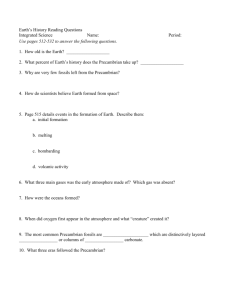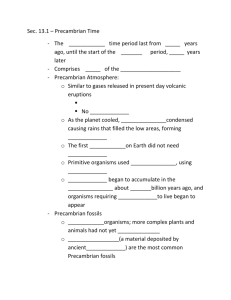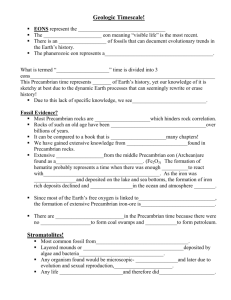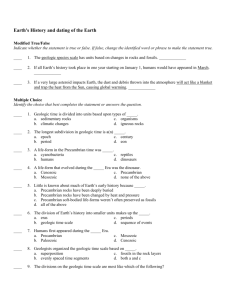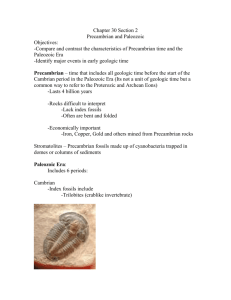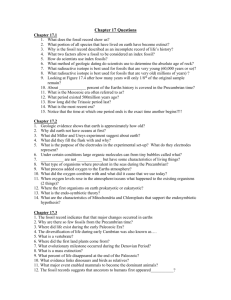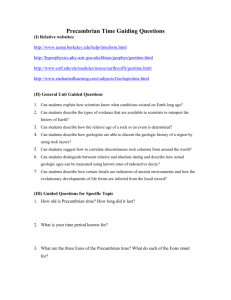Section Review 12-1
advertisement
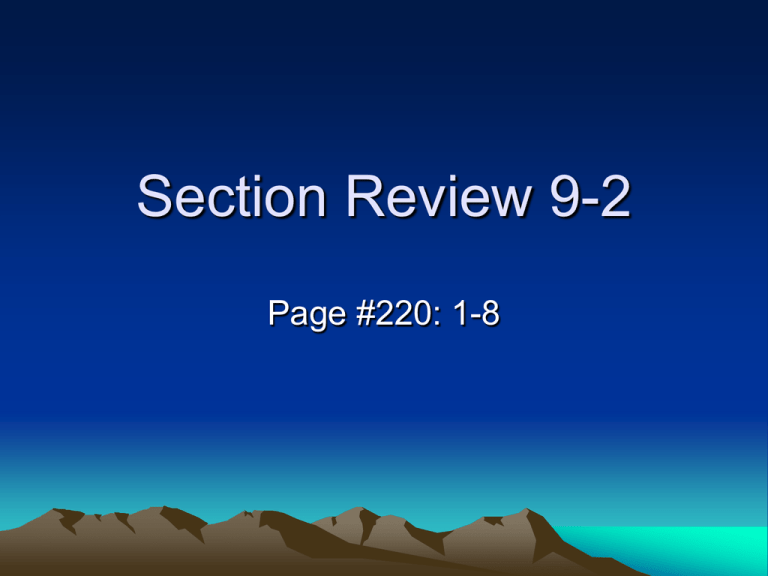
Section Review 9-2 Page #220: 1-8 • What is Ma? Geologic Changes #1 Summarize how evolution is related to geologic change. Geologic changes cause changes in the environment. Climate, elevation, etc. can change which can cause populations to either evolve or become extinct. Fossil finds and Plate Movements #2 Identify two characteristics of most Precambrian rocks. They are highly deformed and contain few fossils. Precambrian Rocks Canadian Shield- Precambrian Rock 3.9 billion years old #3 Explain why fossils are rare in Precambrian rocks. Most Precambrian organisms were small and soft bodied. The rocks have also been highly deformed and altered from their original state. Precambrian rocks in United States Precambrian Fossils • Stromatolites are the most intriguing fossils that are our singular visual portal into deep time on earth, the emergence of life, and the eventual evolving of the beautiful life forms from Cambrian to modern time. • Stromatolites are laminated structures built mainly by cyanobacteria (sometimes known as blue-green bacteria or, less correctly, as bluegreen algae). They are still found today, but were once much more common. They dominated the fossil record between about 2000 million and 1000 million years ago. Nowadays they are found mainly in saline lakes or hot spring environments, often in environmental niches that other organisms cannot tolerate. Stromatolites #4 Identify one life-form from each of the six periods of the Paleozoic Era. Cambrian: trilobites Ordovician: mollusks Silurian: echinoderms (like sea stars) Devonian: fishes Carboniferous: amphibians Permian: reptiles Trilobites (Cambrian) Ancient Precambrian sea Mollusks (Ordovician) Echinoderms (like sea stars) (Silurian) Devonian: fishes Carboniferous: amphibians Permian: reptiles #5 Explain why the Devonian Period is commonly called the Age of Fishes. Many types of fossil fish have been found in rocks from this period. Devonian Fishes #6 Describe the kinds of life-forms that became extinct during the mass extinction at the end of the Permian Period. Many types of marine invertebrates became extinct. (like trilobites) Permian mass extinctions • A theory that an abrupt and dramatic rise in atmospheric levels of carbon dioxide triggered the massive dieoff 251 million years ago. #7 Identify one way in which the formation of Pangaea affected Paleozoic life. When Pangaea formed, inland seas disappeared and organisms that lived in those seas evolved or became extinct. Formation of Pangaea • Former oceans were destroyed as land masses collided. This trapped and killed ocean life. #8 Why is Precambrian time ----about 88% of geologic time---- not divided into smaller units based on the fossil record? The fossil record of Precambrian time contains few fossils so there is not any reason (or guideline to use) to subdivide it. Fossil Record The End????
